The xylophone is a fantastic first instrument to learn. Different levels of xylophones range from elementary music basic xylophones all the way up to 3-4 octave orchestral xylophones. When learning to play and read music, you always start with primary songs and build from there.
Below is a list of 20 Easy/Beginner Xylophone songs that become more technically challenging as the list goes. These are all songs beginners will learn to understand music notation and practice using both hands while playing.
1. Hot Cross Buns
Hot Cross Buns is one of the first songs you will play when learning a new instrument. Hot Cross Buns is a great beginner song for any instrument because it is composed of only three notes!
The notes are E, D, and C; that is it.
For beginner xylophone players, this song can be played using one hand holding a mallet or with two, making it easy for young children to play and memorize in very little time.
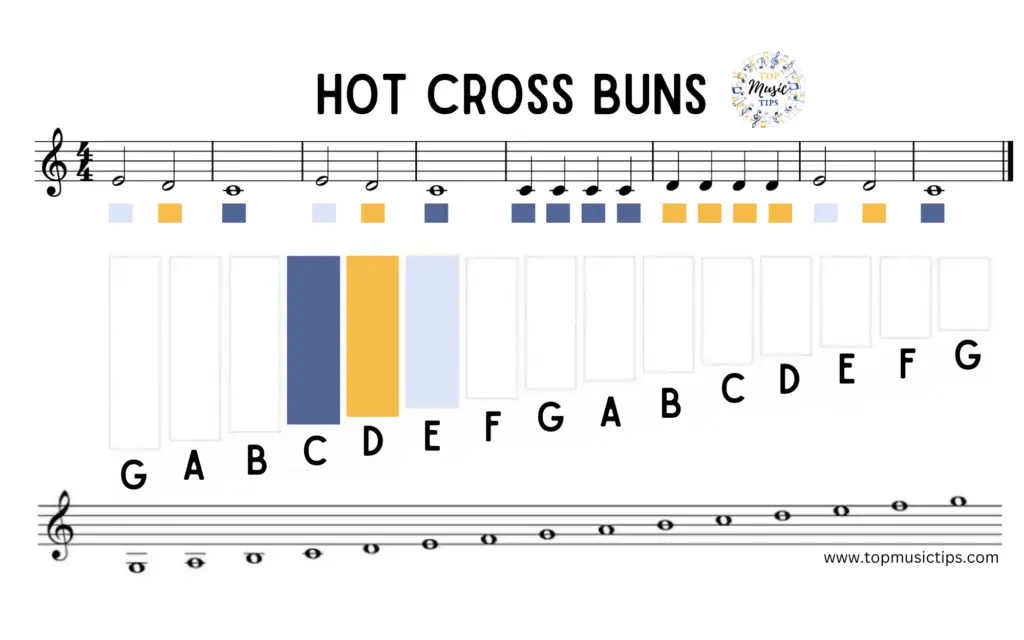
This song can also be played on a glockenspiel as well (if you don’t own your own xylophone). Check out the video below to see a musician demonstrating how to play Hot Cross Buns on the Xylophone.
2. Mary Had A Little Lamb
Just like Hot Cross Buns, Mary Had A Little Lamb is another nursery rhyme that is among the first songs a musician will learn to play.
Mary Had A Little Lamb consists of four notes, C, D, E, and G. The first three notes are used in Hot Cross Buns, meaning only one new note is introduced to play this song.
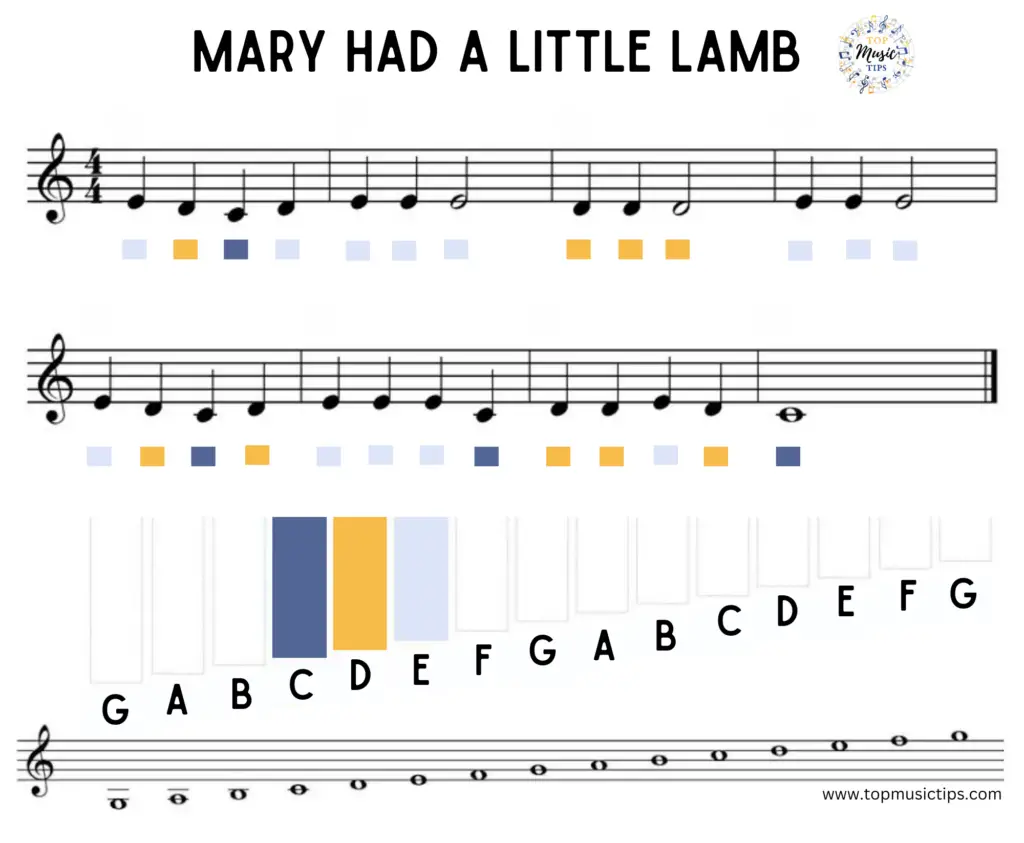
There is also a repeat in this song so musicians can learn what to do when they encounter a repeat and the two different ending bars. Check out the video below to see and hear what Mary Had A Little Lamb is like on a xylophone.
3. When The Saints Go Marching In
When The Saints Go Marching In is an easy song to play on the xylophone because it only involves five notes: C, D, E, F, and G. Increasing the number of notes is natural when learning to read music and play an instrument.
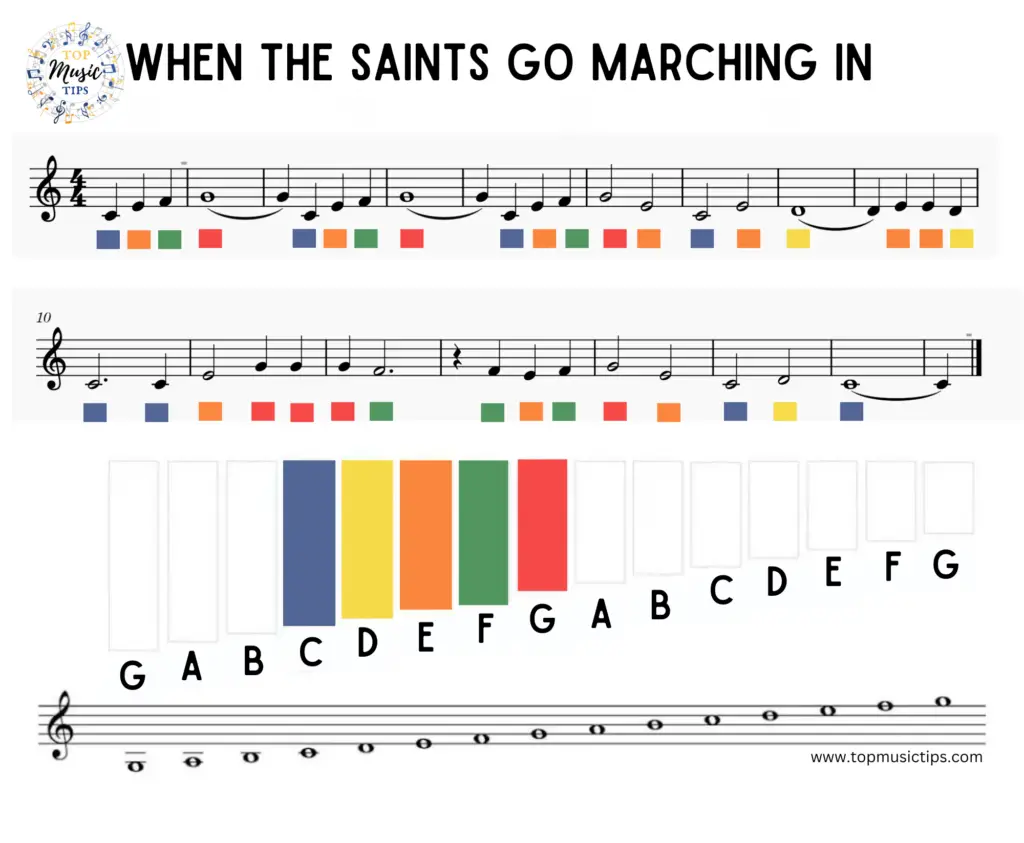
This song also introduces a new musical concept, the tie. A tie connects two notes with the same pitch together and indicates it should be played as a single note, matching the number of beats the notes indicate.
In When The Saints Go Marching In, a whole note, which is worth four beats, is tied to a quarter note, which is worth one beat. So in this song, the ties will be held for five beats.
Once you have the ties down, what naturally comes next is a slur which allows you to develop articulation skills to make your music even better. Check out the video above to hear and see how When The Saints Go Marching In is played (be sure to listen for the tied notes).
4. Twinkle, Twinkle, Little Star
Twinkle, Twinkle, Little Star is the next song you should learn to play on the xylophone. This song adds two more notes to a building repertoire and is comprised of six notes: C, D, E, F, G, and A.
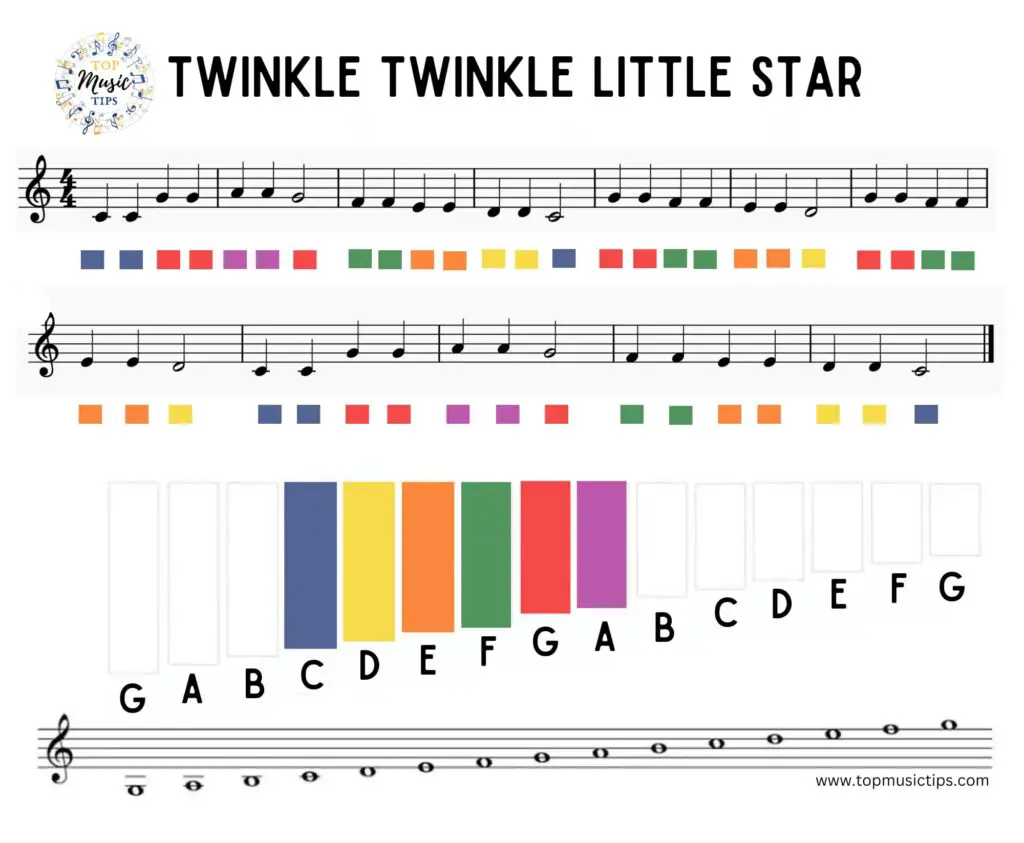
While this song isn’t the most exciting piece of music you will ever play, this is a primary song that helps you learn to identify notes on the staff, note names, and start to differentiate the lengths of different notes combined.
Check out the video below to hear and see how to play Twinkle, Twinkle, Little Star on the xylophone.
5. Baby Shark
Baby Shark is a catchy and fun song that has become a sensation among young children and families alike. This playful tune is perfect for beginners on the xylophone as it primarily uses four simple notes: C, D, E, and F.
This fun little tune introduces the repeat sign. The two dots at the very end of the song signal that you should repeat the song over again.
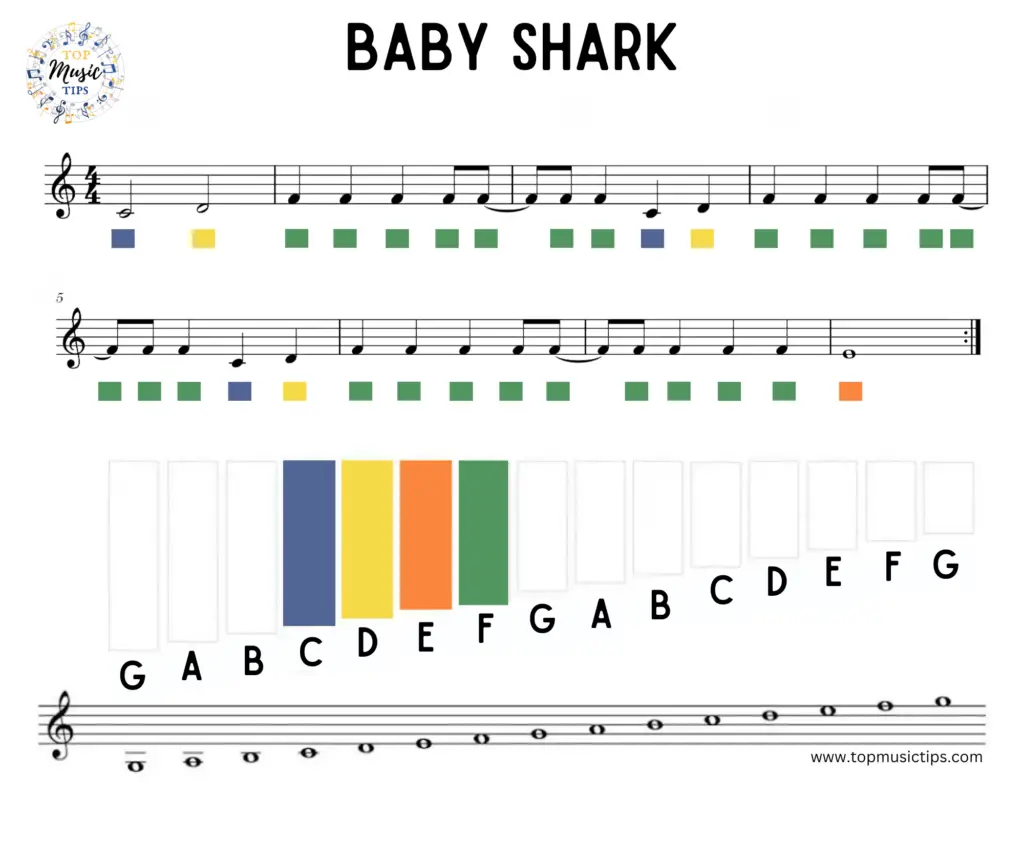
Just like the previous songs, Baby Shark is designed to help budding musicians familiarize themselves with basic note reading and rhythm. It’s a great addition to your xylophone repertoire, especially if you want to entertain and delight young listeners with this popular melody.
To play Baby Shark on the xylophone, follow the color-coded notes on the sheet music provided. Check out the video below to see how to play this cheerful and beloved song. Get ready to dive into the musical world of Baby Shark and create joyful melodies on your xylophone!
6. Frère Jacques
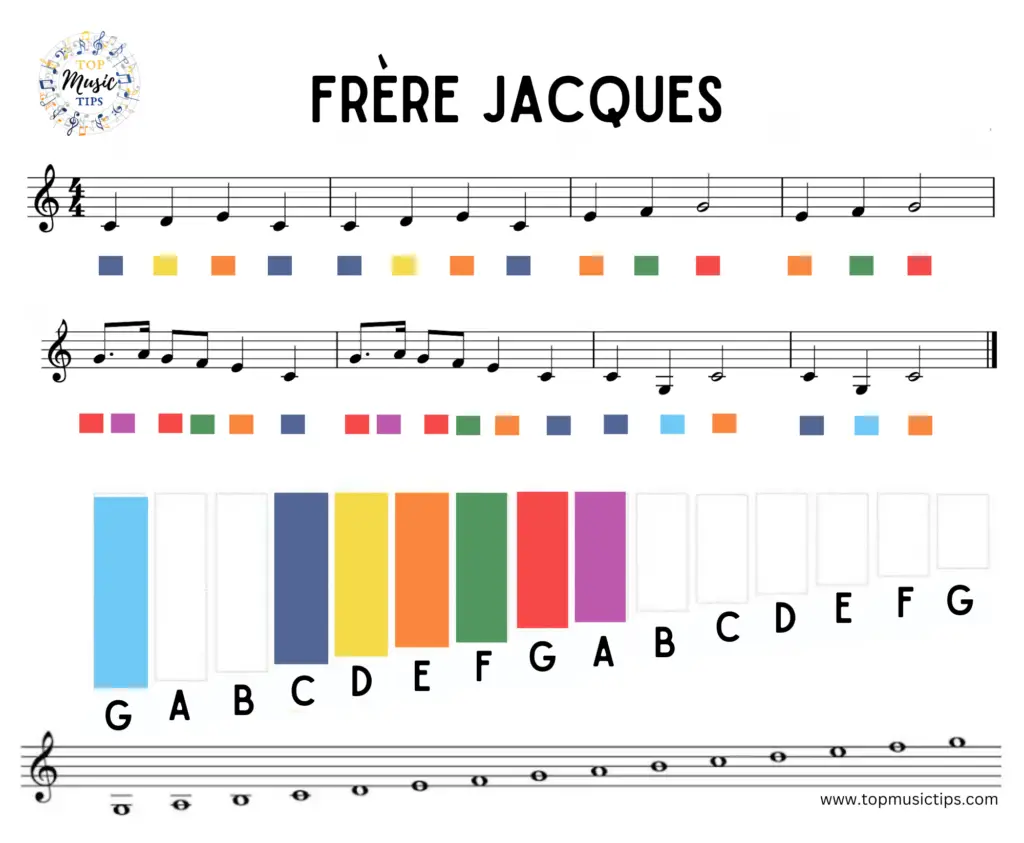
Frère Jacques is a great beginner song for xylophone players. Most people learned this song when they were little, and the melody is instantly recognizable, which makes it easier to play when you are just starting your musical journey.
The song itself is composed of only six notes: C, D, E, F, G, and A. This song is also great for working on using both hands/mallets to play, which is an important part of learning the proper xylophone technique.
Check out the video below to see and hear what Frère Jacques sounds like on the xylophone.
7. Old McDonald Had A Farm
Old McDonald Had A Farm might seem like an easy song to play, but it introduces more complex rhythms, which is important when learning to play an instrument. While the notation might be intimidating at first glance, knowing how the song is sung will help you comprehend these rhythms.
Since the song can last as long as you want, simply adding new animals and playing the song over and over again can help you memorize this piece of music with little to no effort. Check out the video below to hear how to play this song.
(Note: The video does not use the same notes as the sheet music above; that is okay, but be sure to play the notes on the sheet music in front of you).
8. Row, Row, Row Your Boat
Row, Row, Row Your Boat is a standard piece to play on any instrument when you first begin playing.
The song itself has more advanced notation comprised of quarter notes, eighth notes, dotted half notes (also known as three-quarter notes), and one of the best introductions to beamed eighth notes.
There are only six notes in this song and if you have played the three previous songs, you will already know all the notes right away! This song is a good beginner for the xylophone because it can be played in a round if you have another person to play with.
Playing in a round helps you develop your tempo, music reading, and listening skills which are all incredibly important when it comes to playing music.
Check out the link below to hear and see how simple Row, Row, Row Your Boat is when played on a xylophone.
9. Jingle Bells
The holiday classic Jingle Bells is a fantastic song for a beginner xylophone player to learn. This song has more complex rhythms, which might seem intimidating initially when you look at the sheet music.
Still, there is nothing to be afraid of—knowing how the song goes when singing it during the holidays or when caroling can help you understand sheet music more than you think. Your brain can help connect the rhythm to the notation, so when you encounter beamed notes in the future, you will know how to play them.
Plus, this is a great song to play for your guests at Christmas time to show off your new xylophone skills! Check out the video below to hear and see how to play this song using both mallets.
10. Ode To Joy
Ode To Joy is most musicians’ first introduction to the music of Ludwig van Beethoven. The song is the central theme from Beethoven’s 9th Symphony, and it’s a bit more complex but still perfect for beginners.
Ode To Joy is also an excellent song to work on consistently using both mallets rather than only one. A great tip for working on this song is to practice singing what you see on the sheet music. Check out the video below to hear and see how to play Ode To Joy on the xylophone.
11. Oh, Susanna!
Oh, Susanna! Is an excellent and easy song to learn on the xylophone. This song is composed of only six notes: C, D, E, F, G, and A. This is the first song on this list in the 2/4 time signature, which allows a musician to learn how to count note lengths without the music being overly complex. Simple is the best way to start.
Again, starting with a song you most likely learned as a little child makes understanding rhythm and its notation on sheet music a lot easier because you already know how the song is supposed to go. Check out the video below to see and hear how Oh, Susana! Is played.
12. Pomp and Circumstance
Pomp and Circumstance is part of a group of six military marches composed by British composer Sir Edward Elgar. While you might not know the song’s name, if you have ever been to a graduation ceremony in the United States, this is the song traditionally played when the graduating students walk across the stage to receive their diplomas.
Pomp and Circumstance, or “The Graduation March,” is a relatively simplistic song, but what makes it excellent for beginners is that the time signature is in 2/3 time.
This is the time signature of most classical marches, and it is important to learn how to play in this time signature. Check out the video below to listen to how to play Pomp and Circumstance on the xylophone.
12. O Come All Ye Faithful
Another beginner xylophone song that is perfect for the holiday season is O Come All Ye Faithful. The song itself is basic, but what makes this song worth learning is the addition of more than one accidental in the key signature.
This song is in the key of D major, which means all Fs and Es become F# and E# for the entire song. Being able to look at the key in a piece of music is written in and identify what notes are sharp or flat is an essential musical skill to develop.
When looking at a piece of music, the first thing a musician needs to identify is the key the song is written in and the time signature. This information tells you what to expect in the music going forward. Check out the link below to hear and see how to play O Come All Ye Faithful on the xylophone.
(Note: The video uses a glockenspiel, but it would look exactly the same when played on a xylophone).
13. You Are My Sunshine
You Are My Sunshine is another great beginner song to play on the xylophone for many reasons. This song uses six “natural” notes; this means the notes are not sharp or flat. Those six notes are: C, F, G, A, C, and D.
You Are My Sunshine also introduces an accidental note, Bb, and is indicated before the time signature.
This song has a repeat which is important to learn how to both read and play when you are just starting to learn a new instrument. The song is familiar to many people and is an example of a song that is played exactly like it is sung without using sheet music. Check out the video below to see and hear what You Are My Sunshine would sound like on the xylophone.
14. La Cucaracha
La Cucaracha is an incredibly popular Spanish language song, and both kids and adults can have fun singing and playing this song.
This is the first beginning song that is mid-beginner level, but playing the 12 other songs on this list and practicing them will prepare you to play La Cucaracha like a pro.
This song has elements like quarter rests, repeats, ties, beamed eighth notes, and since the song is written in F major, there is one note with an accidental (Bb). Check out the video below to hear and see that La Cucaracha is easier to play than it looks!
15. Star Wars Imperial March
The music from Star Wars is trendy for concert bands, orchestras, marching bands, and beginner xylophone players! At first glance, this song seems complicated, but by this point, you will have learned all the notes, rests, and how to count music, so the rest is only reading.
The Imperial March is a classic, and it is written in the key of Bb major, so Bs and Es will become Bb and Eb. A new skill that musicians will work on with this piece is additional accidentals written in the music.
Start slowly at first to become comfortable with the accidentals, and once it becomes comfortable at a slow speed, gradually increase the tempo as you practice. Check out the fun video below to better understand what The Imperial March on the xylophone will sound like.
16. The Addams Family Theme
The Addams Family Theme song is catchy and sometimes used in science classes to help students learn about atoms and their different components. What makes this song great for beginner xylophone players is the use of triplets.
These three notes played in quick succession and make up the song’s chorus. All you need to do for the snaps is click your mallets together to imitate the snapping sound.
Like all the other songs on this list, this song is played just like you would sing or hum this classic theme song. Remember to use both mallets as you play and to start practicing the song slowly with a metronome before working on speeding your playing up to the normal tempo.
Check out the video below to see and hear what The Addams Family Theme sounds like when it is played.
18. Dance of the Sugar Plum Fairy
The Dance of the Sugar Plum Fairy comes from the ballet The Nutcracker by Russian composer Pyotr Ilyich Tchaikovsky. The original song was written to be played on an instrument called a celesta. A celesta resembles a small piano, but it sounds almost identical to the glockenspiel.
You can play The Dance of the Sugar Plum Fairy at Christmas time or anytime you want to impress someone by playing a famous piece of classical music. This song, like many others on this list, uses a mix of rhythms and accidentals which can feel like a challenge when first sight reading this music.
It is an advanced-beginner song, but it is excellent for using both mallets, and you can listen to hundreds of recordings of this song online to help you hear the piece if you get stuck. Check out the video below to see and hear The Dance of the Sugar Plum Fairy!
19. Pirates of the Caribbean – He’s a pirate
The main theme from the Pirates of the Caribbean movies, He’s a Pirate, is an excellent beginner xylophone song. There is the full version of the song, which is much longer, or the “easy” version, which is pictured above.
No matter what version of the song you wish to learn, the song is instantly recognizable and really fun to play. The music itself is simple when compared to other songs on this list, and the key is in F Major, which means all Bs become Bb, and there is a repeat which is incredibly common in music.
Check out the video below to hear how this song sounds.
20. Hedwig’s Theme
The last song on this list is Hedwig’s Theme from Harry Potter. This song is usually played using a glockenspiel, but a xylophone also works but gives the song a darker pitch. What is essential to know about Hedwig’s Theme is that the time signature is 3/8.
This means the song has three beats per measure, and each beat is the length of an eighth note. This is a more advanced time signature, but since the song is well-known, it is easier to play than you might think. If you were to hum or sing this song, that is how it should be played.
Another great feature of this song is that the tempo is naturally slow, so you don’t have to worry about playing super fast. Listen and watch Hedwig’s Theme from Harry Potter being played on the glockenspiel.
Disclaimer: This post may contain affiliate links. We only recommend high-quality products that are used and recommended by real musicians. If you use these links to buy something we earn a small commission.
